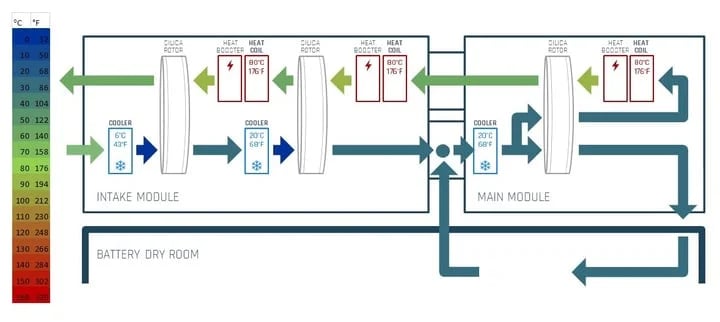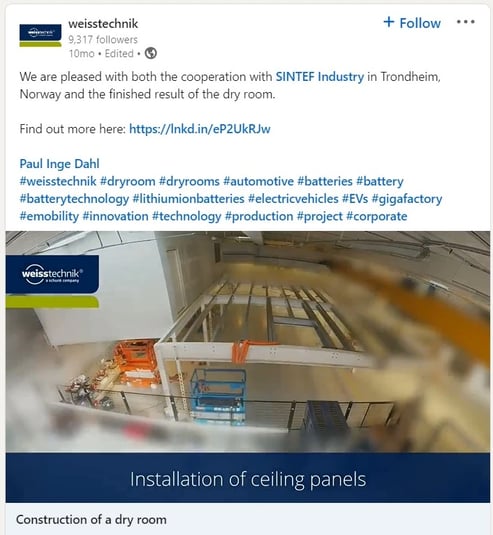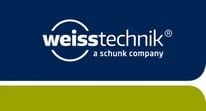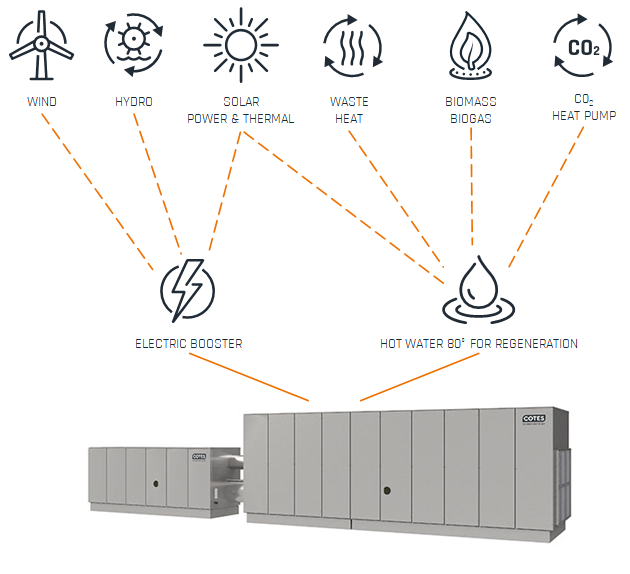[source] Press Release: https://www.weiss-technik.com/environmental-simulation/en/news/detail/weiss-technik-builds-a-dry-room-system-in-norway~n17227
New battery research facility looks towards the future
SINTEF is one of Scandinavia’s largest independent research organisations based in Trondheim, Norway and has partnered with Weiss Technik to build a dry room system for a new battery research facility in Norway.
Norway, in particular, is committed to the transformation to new energy sources and is giving battery cell production a strong push. SINTEF has been developing scientific know-how in the fields of technology, natural sciences, medicine and social sciences for more than 70 years now and this new facility will advance the research and development, as well as the production, of lithium-ion batteries for next-generation electric drives.
Dry rooms are crucial for efficient and safe battery production. A constant room climate with extremely low humidity is crucial for the quality and functional safety of the lithium-ion batteries with regard to the moisture-sensitive production process.
THE RIGHT WAY TO DRY BATTERY DRY ROOM
To keep the extremely dry production climate constant under all conditions, the dry room is separated airtight from the surrounding production building as a room-in-room solution. A slight overpressure of the system protects the chamber from the penetration of humid outside air. Inside the chamber, moisture is removed from the air according to the principle of adsorption dehumidification using the Cotes Ultradry dehumidifier.
ENERGY-EFFICIENT DRY-AIR SYSTEM
For the SINTEF system, Weiss Technik is designing and supplying the cell construction and the demand-oriented dehumidification technology for the dry room, which measures around 155m2. The customer’s target is a constant dew point temperature in the room of -42.5°C with maximum energy efficiency. This is achieved by using one of the most energy-efficient and sustainable dehumidification systems on the market (Cotes Ultradry dehumidifier) provided by Cotes.
COTES PATENTED EXERGIC TECHNOLOGY

How it works
The air stream to be dried is cooled down to nominal dewpoint temperatures before it flows through a layer of fibre fleece, which has a structure of bonded silica gel and metal silicate and is dehumidified to the required dew point temperature. The air stream is dehumidified three times before entering the dry room.
The low-temperature dry-air needs (almost) no post-cooling before entering the dry room which makes the system more efficient.
The ultra-dry air with a dewpoint of -42.5°C circulates in the dry room before it is mixed up with an airstream with similar humidity which is more efficient than mixing it with contaminated (humid) air.
In the counterflow, the moisture adsorbed in the silica gel is expelled by means of hot regeneration air. With this system, a continuous dehumidification process with dew point temperatures between -40 and -70°C can be achieved using low nominal regeneration temperatures of 80-90°C. Every rotor can run at a low temperature which makes the systems more energy-efficient and sustainable.
Low nominal regeneration temperatures are unique to the Cotes Ultradry dehumidifiers that use the Cotes Patented Exergic Technology. These low regeneration temperatures mean that you can use hot water as a heat source and using hot water as the heat source means the new SINTEF facility will be able to choose from a range of sustainable energy sources to heat the hot water needed for heating the regeneration airflow.
COTES SOLUTION
- Ultradry Adsorption Dehumidifiers
- 1 intake + 1 main unit
- Supply dew point at -45°C
- 4 persons in the dry room
- Return air at 21°C
The video above shows the Cotes Ultradry Dehumidifier for SINTEF being hoisted by a crane onto a truck for transport.


The Weiss Technik companies
The Weiss Technik companies include the product areas of environmental simulation, heating technology, air conditioning technology and pharmaceutical technology ( www.weiss-technik.com ). Customers receive solutions and products that are used in research and development as well as in production and quality assurance. A strong sales and service organisation with 22 companies in 15 countries at 40 locations support the customers and ensures the operation of the systems - around the globe. The Weiss Technik companies are part of the Schunk Group based in Heuchelheim near Gießen.
Schunk Group
The Schunk Group is a global technology company. The company is a leading supplier of products made of high-tech materials – such as carbon, technical ceramics and sintered metal – as well as machines and systems – from environmental simulation and air conditioning to ultrasonic welding and optical machines. The Schunk Group has around 9,000 employees in 29 countries and achieved sales of €1.2 billion in 2020.
Cotes Exergic Technology for battery dry rooms
Cotes offers an Ultradry-air Solution for battery dry rooms that uses our Cotes Patented Exergic Technology, enabling massive energy reductions, cost savings, and huge CO₂ emissions reductions of up to 95%.
Did you know that:
- Dehumidification for battery dry rooms counts for 43% of energy consumption in battery cell production
- Cotes Exergic Technology can cut battery dry room dehumidification energy consumption by 30-50%. The remaining energy required for drying the battery dry room can be sourced from waste heat or heat pumps, enabling a total reduction in a range of 80-90%.
- It is possible to reduce the cost of the energy bill for dry room dehumidification by up to 66%
- With the right dry-air solution for your battery dry room, it is possible to cut the total CO2 footprint of battery packs by 7-9%
|
If you are a car or battery manufacturer that wants to go green(er) and save costs, then reach out to us. Cotes can help you find the right dry-air solution for your facilities and give you the competitive advantage of a more sustainable Li-ion battery. Contact Joris Vieux, Global Manager Battery & |
|
Are you curious about the potential energy savings for your battery dry rooms? Take a look at our free online calculator below.



.webp)